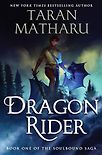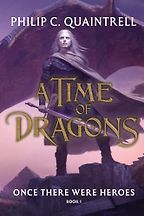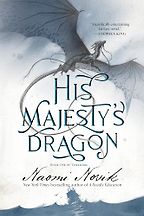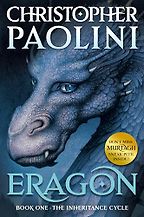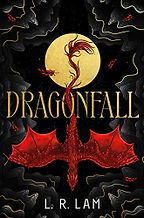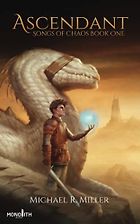Dragons are one of the oldest and most ubiquitous mythic creatures, present in almost every culture – a fact that has been variously attributed to fear of snakes, the need to explain dinosaur bones, or convergence of speculation about rain and drought. They’re always somewhat serpentine, but there have been a lot of different types. Could you introduce us to the types of dragons we see in fantasy today?
There’s such a broad approach to dragons. In some books, the dragons are quite human. They might be able to transform into a dragon. Some of them are just animals. Some of them can speak, often telepathically. Sometimes they have four legs, sometimes they have two legs… If a dragon has two legs and two wings and doesn’t have front legs, I think of them more as wyverns than dragons, but that’s just my own personal dragon philosophy!
Medieval bestiaries are on your side there, right? That is a wyvern!
I’m a real stickler for getting the right number of legs on dragons. I remember when my publisher was making my cover for the Dragon Rider series, the initial sketches included the wrong number of legs, and they were gracious enough to change that.
Could you introduce us to your first (four-legged) choice: Ascendant by Michael Miller?
Michael R. Miller’s book is an independently published book, self-published, but it’s available in audio, paperback and e-book – and I think it’s even in a few select stores, because it’s become so immensely popular. It’s a story of a traditional hero’s journey. The protagonist is a pot washer: his name’s Holt, and he’s very low down in the hierarchy of this world. He works in the kitchens, and doesn’t even get to cook himself, he just cleans the pots. In this world the dragon riders are the top echelon – they’re the warriors, they’re the nobility. They have quite a brutal practice, similar to the Spartans, where if there’s a dragon egg that’s damaged or disabled in some way they will destroy it. Holt is totally against this practice, and he saves an egg that looks like it’s going to be culled and keeps it for himself in secret. It results in Ash, a very rare white dragon, and a blind dragon. The blindness of his dragon actually becomes one of their strengths, because it gives them unique strategies with their magic, and a tremendously strong bond. Michael has cystic fibrosis and so was able to lean on his own experiences writing from Ash’s perspective, as well as using physiotherapy techniques that he does as part of his treatments to inspire the meditations used by riders in the book.
In this world, there’s a growing threat called the Scourge. They’re an undead horde who are wreaking havoc across the world, and it’s up to Holt and his dragon to fight them. They end up becoming far more important in this battle between good and evil than anyone thought they would be. That’s the general plot, without spoiling too much!
“Dragons have four legs; wyverns have two legs and two wings”
What I find exciting is the uniqueness of the magic system. There’s a very interesting genre that’s been growing at a pace over the last three years, called the ‘cultivation’ genre. It’s got this huge audience, but it’s both niche and yet somehow so large that some of the books in this genre will hit number one on the whole of Amazon for weeks on end. Yet it hasn’t filtered through to the wider traditional print-book reading audience; it’s still almost entirely in the self-publishing space. My book Dragon Rider will actually be the first traditionally published cultivation novel.
Cultivation fantasy is based on Eastern mythology and novels that have become more popular recently, and they feature an ambient magic energy or force around the world, and characters who are cultivators – although they might be called dragon riders, magic practitioners or wizards, whatever it might be. They are able to absorb this ambient energy into themselves, into a core inside them, which is often described as a metaphorical crystal that they have inside them. They have to meditate to bring this ‘mana’ or magic into themselves; their core is effectively a hollow crystal that stores this magic. And as time goes by, they do things to improve their abilities. So, they might expand their core to be larger; they might shape their core into a spiral so that when the magic goes in, it’s purified and becomes even more potent; they might grind their crystal to make it smooth on the outside, and that does something… Every cultivation book does it differently. It’s effectively about levelling yourself up. It’s progression fantasy in that sense. It might be you’re bronze tier to begin with, then you move to silver, then gold, then platinum, then jade… eventually the writer realises that they need to keep writing books, they’ve run out of tiers, and they start going with completely invented stuff – ‘Space tier!’ – and so on.
So that’s the genre. And Michael has done what I’m also trying to do in Dragon Rider: taking the traditional westernised fantasy and melding it with this Eastern-inspired, very specific progression fantasy magic system. He puts them together really well.
And am I right, they cultivate their power in this case from the dragon, the dragon’s core?
Yes, so it’s a conduit for them more than anything. So it’s slightly different to where it’s all on you – it’s more about the bond with the dragon.
The idea of taking power from dragon is very old – Sigurd drinks Fafnir’s blood in Norse mythology, Cadmus sews the dragon’s teeth in Greek mythology – but now when we tell the tale it’s not butchery, it’s bonding and dragon-riding.
Dragon riders feature in your next choice too: Once There Were Heroes by Philip C. Quaintrell. Could you tell us a bit about it?
Once There Were Heroes is the first book in Quaintrell’s ‘A Time of Dragons’ series. It’s part of a wider universe by this self-published author, but you don’t need to read any of the other books to step into this one. It’s completely independent; there are no shared characters.
It’s set in the land of Eridor. In this world, people who are heroes – who have done brave deeds and got their names down in history – earn the right to become a dragon rider. The eggs will sometimes wait thousands of years to find a warrior that’s worthy of bonding with them. I think that’s quite trope-y in general with dragon riding, but it bears repeating here because it’s one of the key themes.
No heroes have arisen for quite a while and the existing heroes are dying out, so the dragon riders are a dying group. There’s very few of them around, and there’s a war going on between the dragon-rider territory Erador, and the alchemical, elf-like Andarens. They have their own mounts, which are these sort-of mutated eagles – part of their magic is mutation, they mutate themselves. So it’s almost like Top Gun! You’ve got mutated-eagle-riding dark elves and dragon rider heroes, battling in the skies for supremacy in this war. But it’s mostly at this point fought by foot soldiers. And then a dark ancient evil is awakening, and it takes no sides in this war – there’s various people trying to take advantage of it, but it’s ultimately it’s just a big bad evil that wants to kill everyone – and new heroes must arise.
It’s told from multiple points of view. There’s no one main character. But you know one of them will become a dragon rider…
Dragon riding – a very Chinese tradition – seems to be in vogue. Is slaying dragons out of fashion in fantasy at the moment?
I think that in the world of today, people are looking more for escapism than the dark and dreary. They want a fantasy to escape into. I don’t know about you, but I’d much rather dream of riding a dragon into battle and having this awesome, powerful, ancient companion to fight alongside me, than going out and killing something. I put dragons on a bit of a pedestal; I don’t like the idea of killing one so much as bonding and owning one. Maybe I’m biased because I grew up with Pokemon, and all these pet-related stories. And I wrote the ‘Summoner’ series, which is all about having creatures and bonding with them. I’m pro-companionship!
It feels like this is a trend with a lot of mythic creatures in fantasy at the moment.
I agree. Our old myths were more often slaying beasts. But I did so much mythological research when I was writing the ‘Summoner’ series – I wanted to take mythical creatures from cultures all over the world and place them all in my world, and be one of those horrible writer magpies that just steals from everything that’s shiny and cool – and I think when you do all this research on these fantastic and interesting creatures, the last thing you want to do is to make them the bad guy.
Speaking of your own research, could you tell us a little about your forthcoming book Dragon Rider?
Sure. Again, it’s a story about bonding with dragons. It’s my interpretation of the cultivation magic system in a dragon-rider story. The plot is loosely inspired by the life of Attila the Hun. He was from a pastoral, tribal people that were not as advanced as the great empire of Rome that was spreading, and after a war that was lost in the Roman Empire between the Huns and the Romans, Attila was effectively made a hostage. The Romans would take the firstborn sons of whoever they’d beaten and say, “They’re going to be raised in our court. They’re going to learn our culture. If you decide to war with us again and not pay your tributes, we’ll kill them all.”
In much in the same way, this is the story of a Roman-esque empire that has defeated a pastoral people that led a rebellion. And Jai, the main character, is the son of Rohan, who was the leader of the rebellion, and was executed by Emperor Leonid of the Sabine Empire. The Empire is very Roman-like, with legions and with symbols of griffins, which is obviously like the Roman eagle. They have praetorian guards of a sort, called the ‘griffin guard’; they ride griffins and have their own sect where they study the art of cultivation – which in my story is called soul bonding, and majicking.
Jai becomes Leonid’s personal servant. Leonid has given up his throne for his son, Constantine, and is now an ignored, elderly man living alone in his chambers, writing his memoirs. Jai is helping him write them; Jai’s treated pretty poorly in this world and is very much on the outs.
And then Constantine decides that he wants to finally make peace with the Dansk, who are a northern Viking-inspired empire, and are the only group who know how to bond with dragons. Constantine’s son Titus marries Princess Erica, and in exchange there’s a dowry of a dragon that the prince will be able to bond with. Without spoiling things, there’s a lot of court intrigue and betrayal and there’s a big red wedding type scene, and Jai is forced to flee – and this is the story of Jai and an escaped Dansk handmaiden, the personal handmaiden to Erica. They have to escape to Jai’s homeland far in the east along the Kashmir Road, which is the Silk Road equivalent in my world. It’s all about them being on the run, being hunted – and Jai has a dragon egg that hatches, and bonds with this little dragon.
It’s all about him rediscovering his culture, learning about this world that he’s been trapped out of, learning his magic. Along the way, he encounters a soul-bound warrior who is a grizzled, retired old man – very traditional trope-y hero’s journey….
Did having a particular history and geopolitics in mind shape the value and meaning of dragons?
I really wanted to have a foe that Jai could fight that is perhaps not as powerful as a dragon, but maybe there’ll be more of them, they’ll be more numerous – maybe the riders on the backs of these inferior beasts might be more powerful. So it balances itself out. The griffin riders have a lot of power and influence in this empire. They’re almost a faction of their own. That’s what the Roman flavour gave me.
And I was just so inspired by the story of Attila the Hun. I’ve grown up in Europe as a half-Indian, half-Brazilian person. In many of the schools I went to, I was the one of the only non-white people in my school. So this experience of being a fish out of water in a culture that doesn’t necessarily see you as part of their heritage, at least to begin with, is something that I grappled with as a kid. And I think having that experience perhaps made me better qualified to explore this idea of being raised in a completely different culture and being seen as ‘other’ – but also not, perhaps not necessarily having a good sense of the culture that you’re supposed to be coming from, being third generation.
Jai experiences that: everything he knows is in a culture that’s not necessarily one that he feels entitled to be part of. There’s a history of his people being seen as savage – they’re head takers, they’re cannibals, they’re blood drinkers… And he really doesn’t know what’s true. My ancestors are the Indo-Scythians – as I’m a Sikh from northern India, they claim ancestry to the Indo-Scythians. And they have a very interesting pastoral culture. I’ve tried to apply that in this story to these pastoral peoples.
Your next choice is not just history-inspired, but squarely historical fantasy – very unusual, for dragon fantasy. Could you tell us a bit about His Majesty’s Dragon by Naomi Novik, set in the Napoleonic Wars?
This may be my favourite of the lot, because it tickles so many of my hobbies and things I love. I love gunpowder weapons – I used them in the ‘Summoner’ series, but I wasn’t sure I could pull off Roman Empire with guns for Dragon Rider! But in any case, what’s fantastic about His Majesty’s Dragon is this historical setting. I grew up reading the ‘Sharpe‘ series by Bernard Cornwell, which are all about the Napoleonic wars – it’s the most interesting time of warfare in history for me – so then came this fantasy version with dragons, and I was just completely smitten.
It’s set in 1804 during the War of the Third Coalition. But I really don’t think you need to be a history buff to get on with this book – you don’t need to know what was going on in the real Napoleonic Wars – if you are, that’s great, because there are lots of cool little Easter eggs as you read, but it certainly doesn’t slow down the story.
It’s about Captain William Laurence, who’s on the HMS Reliance. He captures a French ship, and it happens to be carrying a rare Chinese dragon egg. And fate ensues! The dragon Temeraire chooses Laurence as its handler. Once Laurence is bonded to a dragon, he can’t be on a ship anymore – he needs to be fighting with this dragon that he’s bonded with. So he’s brought into Britain’s aerial corps and he’s trained in the art of aerial warfare.
That’s my favourite part of the book actually, where he learns how to fight on dragon-back. I think every book with a dragon rider should have this, if they can. Paradoxically, I’ve not been able to fit that into my own story because of the plot that I’d chosen, but I love it. It’s a fantastic series. The first book is very straightforward, the plot is not too convoluted – it’s very much: gets dragon, trains, a little bit of intrigue, big climactic battle at the end. But it’s just a great experience and journey as you’re reading it. I highly recommend that one.
Your next choice is a more classic epic fantasy – and arguably set the trend for dragon-riding stories: Eragon by Christopher Paolini.
Yes! I’ve included Eragon, not because it’s necessarily the best written or the most unique plot, but because it set the scene for dragon-rider stories, and popularised them in the literary world. It’s a young adult ‘crossover’ book – that is, many adults have read it, many teens have read it. It’s not a complicated world where you need to learn off by heart many unpronounceable names and the history of many diverse places. It’s quite straightforward and easy to get on with. It’s considered a classic by many. I thought it well worth including for anyone who’s not read dragon-rider stories before, and is looking for something entry level – it’s probably the one I would recommend people start with.
It was written by Christopher Paolini, who I believe was fifteen years old at the time! As I understand, he self-published it initially, then went on a big school tour with his parents where they would literally take him from school to school, hand-selling these books after those events. He would come out dressed in character and do a big spiel, and hand-sell the books that way. When traditional publishers noticed his success it was picked up, went to auction, and has now sold many millions of copies.
Five Books interviews are expensive to produce. If you're enjoying this interview, please support us by donating a small amount.
It’s about Eragon, a fifteen-year-old boy. It’s a bit of a cheesy name for someone who ends up bonding with a dragon, but I think it’s explained why he’s called that in the stories. He lives with his uncle and cousin. He discovers a dragon egg, which has been magicked away because many people are trying to acquire it, so it’s been teleported to the middle of nowhere in the mountains where it will be safe – he happens to stumble across it and bonds with it. He grows it from a hatchling to a larger dragon. I believe in the movie, they wanted to skip that whole thing, so they literally had the dragon just fly up into the clouds, where it was hit by lightning, and it comes back as a fully grown adult. Which was very disappointing, I think, for many of the people who love the books.
The big evil emperor – his name’s Galbatorix – his henchmen are searching for them. Eragon suffers a personal tragedy, has to flee, and meets Brom who’s the mentor character. They need to rescue an elf named Aria. There are urgals, which are a bit like orcs in this world, and Nazgul-type characters that are hunting them, and the story culminates with a defensive battle for the rebellion where Eragon plays a very pivotal role with his dragon, Sephira.
I’m interested in this pattern with self-publishing in fantasy. Paolini self-published dragon fantasy, now dragon fantasy is mainstream; it seems like maybe we’re seeing a similar moment for cultivation fantasy…
Yes! I wanted to be diverse in my mix of books – not only have a mix of men and women writers and protagonists, but also include self-published authors as well as traditionally published authors. You can often spot major incoming trends in the e-book market that are very interesting. I’m excited for the insights there, particularly into what gets teenage boys reading. And I’m excited for cultivation fantasy to cross over into the traditional space.
Another self-published author who deserves a shout out is Ryan Cahill, who writes epic fantasy dragon-rider stories. I’ve read some of his books and I think they’re fantastic.
Could you introduce us to your final choice, Dragonfall by L. M. Lam?
This one’s quite different to the other books. I wanted to include something that approaches dragons and dragon riders in a different way – this one’s perhaps less ‘dragon rider’ and more just ‘dragon.’ It’s set in a world where dragons, once betrayed by humans, have been banished to a dark, dying world. As centuries passed, humans forgot that they’d done this, and they start to worship dragons as gods, completely unaware that the dragons they’re worshiping are trapped in another realm. The dragons seek revenge on the humans that banished them.
The story begins with Everen, who’s the last male dragon. He’s forcibly brought to the human world after a heist goes wrong. The human protagonist, Arcady, is an orphaned, gender-fluid thief who inadvertently triggers Everen’s arrival in human form when a heist for a valued artefact goes awry. So for much of the book, one of the main characters is a dragon in human form. For Everen the dragon, their bond is crucial for the survival of his race. As part of the magic of this world, his task is to convince a human to bond with him completely – body, mind and soul – and then kill them to release his kind. And then they start to have a potentially romantic interaction – and it’s all about his dilemma: humans are evil and terrible and they banished us, and now I have to trick one into bonding with me and kill them to free my people, but then I learn that actually humans aren’t so bad and they don’t have a clue that this has happened in their past… A really interesting book, well worth reading.
It’s a queer-normative world, with its own constructed language that Lam spent a great deal of time working on with a doctor of linguistics. So there’s a totally invented language scattered throughout the story.
It’s lovely to see a shape-shifting dragon. We don’t get much of that tradition in current fantasy.
Yeah, I think it doesn’t tickle the same itch for many people. Some people say, ‘I want my dragon to be its own thing, ancient and four-legged’ – they have a very clear idea of what kind of dragon they want in their books. But I think it’s worth adding this in to give people a little bit more variety in their dragon-themed books. There’s so much variety, with the Western approach and the Eastern approach, and the various mythologies… This book is completely unique and different.
Five Books aims to keep its book recommendations and interviews up to date. If you are the interviewee and would like to update your choice of books (or even just what you say about them) please email us at [email protected]

